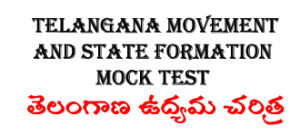
Telangana history from 1948 to 1956 for all competitive exams. Learn Most important questions Telangana Bits For Competitive Exams.
Free Online Mock Test for Telangana History Movement and State Formation Udyama Charitra in English and Telugu Most Important Practice BIts From 1948 to 2014: A brief history of the Telangana movement and State Formation.
Syllabus:
PAPER-IV TELANGANA MOVEMENT AND STATE FORMATION
I. The idea of Telangana (1948-1970)
1. Historical Background: Telangana as a distinctive cultural unit in Hyderabad Princely State, its
geographical, cultural, socio, political and economic features- people of Telagangana- castes, tribes,
religion, arts, crafts, languages, dialects, fairs, festivals and important places in Telangana.
Administration in Hyderabad Princely State and Administrative Reforms of Salar Jung and Origins
of the issue of Mulkis-Non-Mulkis; Employment and Civil Services Rules under Mir Osman Ali
Khan, VII Nizam’s Farman of 1919 and Definition of Mulki – Establishment of Nizam’s Subjects
League known as the Mulki League 1935 and its Significance; Merger of Hyderabad State into
Indian Union in 1948- Employment policies under Military Rule and Vellodi,1948-52; Violation of
Mulki-Rules and Its Implications.
3. Hyderabad State in Independent India- Formation of Popular Ministry under Burgula Ramakrishna
Rao and 1952 Mulki-Agitation; Demand for Employment of Local people and City College IncidentIts
importance. Justice Jagan Mohan Reddy Committee Report, 1953 – Initial debates and demand
for Telangana State-Reasons for the Formation of States Reorganization Commission (SRC) under
Fazal Ali in 1953-Main Provisions and Recommendations of SRC-Dr. B. R. Ambedkar’s views on
SRC and smaller states.
3. Formation of Andhra Pradesh, 1956: Gentlemen’s Agreement – its Provisions and Recommendations;
Telangana Regional Committee, Composition, Functions and Perfomance -Violation of SafeguardsMigration
from Coastal Andhra Region and its Consequences-Post-1970 development Scenario in
Telangana-Agriculture, Irrigation, Power, Education, Employment, Medical and Health etc.
4. Violation of Employment and Service Rules: Origins of Telangana Agitation- Protest in Kothagudem
and other places, Fast unto Death by Ravindranath; 1969 Agitation for Separate Telangana. Role of
Intellectuals, Students, Employees in Jai Telangana Movement.
5. Formation of Telangana Praja Samithi and Course of Movement – the Spread of Telangana
Movement- Major Events, Leaders and Personalities- All Party Accord – Go 36 – Suppression of
Telangana Movement and its Consequences-The Eight Point and Five-Point Formulas-Implications.
II. Mobilisational phase (1971 -1990)
1. Court Judgements on Mulki Rules- Jai Andhra Movement and its Consequences- Six Point Formula
1973, and its Provisions; Article 371-D, Presidential Order, 1975-Officers (Jayabharat Reddy)
Committee Report- G.O. 610 (1985); its Provisions and Violation- Reaction and Representations of
Telangana Employees
2. Rise and Spread of Naxalite Movement, causes and consequences – Anti-Landlord Struggles in
Jagityala-Siricilla, North Telangana; Rytu-Cooli Sanghams; Alienation of Tribal Lands and Adivasi
Resistance- Jal, Jungle, and Zamin.
3. Rise of Regional Parties in 1980’s and Changes in the Political, Socio-Economic and Cultural
fabric of Telangana- Notion of Telugu Jathi and suppression of Telangana identity- Expansion of
new economy in Hyderabad and other parts of Telangana; Real Estate, Contracts, Finance Companies;
Film, Media and Entertainment Industry; Corporate Education and Hospitals etc; Dominant Culture
and its implications for Telangana self respect, Dialect, Language and Culture.
4. Liberalization and Privatisation policies in 1990’s and their consequences – Emergence of regional
disparities and imbalances in political power, administration, education, employment- Agrarian
crisis and decline of Handicrafts in Telangana and its impact on Telangana Society and economy.
5. Quest for Telangana identity-intellectual discussions and debates- political and ideological efforts
– Growth of popular unrest against regional disparities, discrimination and under development of
Telangana.
III. Towards Formation of Telangana State (1991-2014)
1. Public awakening and Intellectual reaction against discrimination- formation of Civil society
organisation, Articulation of separate Telanagana Identity; Initial organisations raised the issues of
separate Telangana; Telangana Information Trust – Telangana Aikya Vedika, Bhuvanagiri Sabha –
Telangana Jana Sabha, Telangana Maha Sabha – Warangal Decleration – Telangana Vidyarthula
Vedika; etc., Efforts of Telangana Congress & BJP in highlighting the issue.
2. Establishment of Telangana Rashtra Samithi in 2001, Political Realignment and Electoral Alliances
in 2004 and later Phase of Telangana Movement – TRS in UPA- Girgliani Committee- Telangana
Employees Joint Action Committee – Pranab Mukherjee Committee- 2009-Elections-AlliancesTelangana
in Election Manifestos- The agitation against Hyderabad as Free-zone – and Demand for
separate Statehood- Fast-Unto-Death by K.Chandra Shekar Rao-Formation of Political Joint Action
Committee (2009)
3. Role of Political Parties-TRS, Congress, B.J.P., Left parties, T.D.P., M.I.M and other political parties
such as Telangana Praja Front, Telangana United Front etc., Dalit-Bahujan Sanghams and Grass
roots Movement organisations – Other Joint Action Committees and popular protests- Suicides for
the cause of Telangana.
4. Cultural Revivalism in Telangana, other symbolic expressions in Telangana Movement- Literary
forms- performing arts and other cultural expressions- writers, poets, singers, intellectuals, Artists,
Journalists, Students, Employees, Advocates, Doctors, NRIs, women, Civil society groups, organised
and unorganised sectors, castes, communities and other social groups in transforming the agitation
into a mass movement-Intensification of Movement, Forms of Protest and Major events: Sakalajanula
Samme, Non-Cooperation Movement; Million March, etc.,
5. Parliamentary Process; UPA Government’s stand on Telangana- All-Party Meeting- Anthony
Committee- Statements on Telangana by Central Home Minister – Sri Krishna Committee Report
and its Recommendations, AP Assembly and Parliamentary proceedings on Telangana, Declaration
of Telangana State in Parliament, Andhra Pradesh State Reorganization Act, 2014- Elections and
victory of Telangana Rashtra Samithi and the first Government of Telangana State.